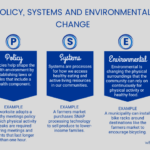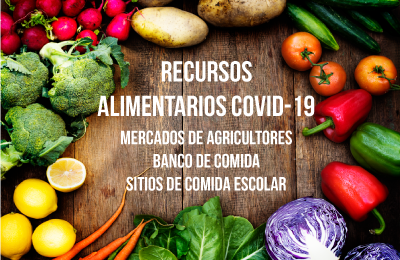
Apr 15, 2020 | News
 Since March 13, Eat Smart Move More South Carolina (ESMMSC) has worked with more than 100 statewide partners to provide emergency preparedness materials and healthy food source locations to partners and the public in the wake of the COVID-19 pandemic.
Since March 13, Eat Smart Move More South Carolina (ESMMSC) has worked with more than 100 statewide partners to provide emergency preparedness materials and healthy food source locations to partners and the public in the wake of the COVID-19 pandemic.
ESMMSC has been working with organizations such as local school districts, farmers, food pantries and community coalitions, SC Department of Education, SC DHEC, SC Farmers Market Association, Carolina Farm Steward Association, senior services, SC Hospital Association, SC Office of Rural Health, Healthy Learners, Food Research and Action Council, and SC Food Policy Council to identify needs, available services, capacity, and connect partners who normally would not work together.
“As a result of the food insecurity partnership during the COVID-19 pandemic, gaps in food distribution services that include staffing, equipment, transportation, physical distribution, public-private partnerships, and planning have been identified,” said Meg Stanley, executive director at ESMMSC. “As food insecurity needs increase, convening and connecting continues with all levels of consideration being presented.”
Part of the solution to the food insecurity issue is the Food Insecurity Resources webpage, which contains funding opportunities, guidelines, food system support, food insecurity data, and low- or no-cost healthy food sources for communities and organizations across the state. Since the webpage went live on March 20, ESMMSC has experienced an increasing amount of traffic to the website. Nearly 6,000 people from across the country have visited the page with 1,588 people clicking on the various links on the page.
“While we are thrilled the webpage is valued by partners and organizations, it is not the end-all of our work related to this crisis. We are assisting other organizations by addressing food delivery barriers and we’re seeking new funding to support community-level organizations with sourcing healthy food,” said Meg Stanley, executive director at ESMMSC. “We also continue to update the webpage daily with new and updated information, including information in Spanish.”
ESMMSC worked with Healthy Learners and SC PASOS to translate a portion of the page into Spanish. The Local Activity section, as well as the SC Food Banks and Farmers Markets spreadsheet located under Statewide Activity, will help the Latinx community find local healthy food.
“Our Latinx community is just as important as any other group. They make up a large part of the food insecure population,” said Stanley. “Because ESMMSC has a strategic focus on equity and inclusion, we felt it was imperative to provide a Spanish translation.”
The COVID-19 pandemic has put a spotlight on emergency preparedness within organizations and the importance of partnerships in addressing food insecurity during this time of crisis. Luckily, ESMMSC has a strong network of partners who have been working tirelessly to ensure South Carolinians have access to healthy food and organizations have access to best practices.
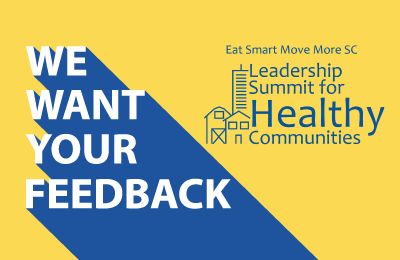
Apr 15, 2020 | News
 Social distancing has changed the way we all do business these days, thanks to the COVID-19 pandemic. It has created a massive amount of uncertainty, heightened awareness of our environments, and moved most of our work to the virtual format.
Social distancing has changed the way we all do business these days, thanks to the COVID-19 pandemic. It has created a massive amount of uncertainty, heightened awareness of our environments, and moved most of our work to the virtual format.
Because of this uncertainty and to maintain healthy social distancing during the unforeseen future, Eat Smart Move More South Carolina (ESMMSC) will not be hosting the 2020 Leadership Summit for Healthy Communities. Instead, the annual healthy eating and active living conference will be moved to early 2021, a move that will position the event to reach more coalitions and public health professionals during a time of year when not many healthy eating and active living conferences happen. In lieu of a fall event, ESMMSC is planning a multitude of webinars, some of which will be free.
“Continuing education plays an important role in keeping coalitions and public health professionals abreast of the latest successes and barriers associated with policy, system, and environmental change strategies,” said Meg Stanley, executive director at ESMMSC. “To ensure we provide the appropriate webinars, we are asking our coalitions and partners to help us by completing a survey of their education and training needs.”
The brief survey will allow ESMMSC staff and the Leadership Summit Planning Committee to brainstorm webinar topics and design an online experience that will be beneficial and engaging. To complete the survey, click here.
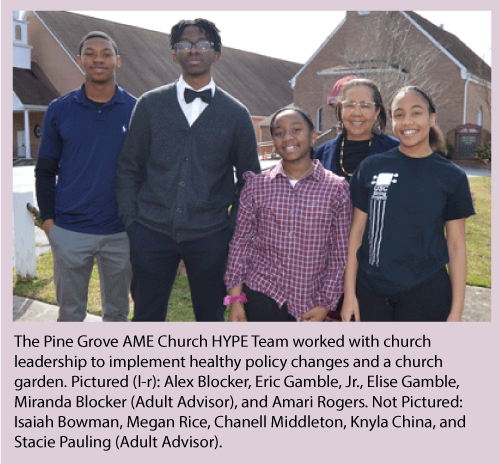
Mar 20, 2020 | News, The HYPE Project
 A youth group at Pine Grove AME Church are trying to do something about the health of their community by implementing health policies and educating the congregation on the importance of living a healthy lifestyle. Through a partnership between Eat Smart Move More South Carolina and the 7th District AME Church, nine teens and pre-teens involved in Pine Grove’s Young People Division (YPD) had a chance to participate in The HYPE Project and learn about policy, system, and environmental change and the positive impact they can have on their community.
A youth group at Pine Grove AME Church are trying to do something about the health of their community by implementing health policies and educating the congregation on the importance of living a healthy lifestyle. Through a partnership between Eat Smart Move More South Carolina and the 7th District AME Church, nine teens and pre-teens involved in Pine Grove’s Young People Division (YPD) had a chance to participate in The HYPE Project and learn about policy, system, and environmental change and the positive impact they can have on their community.
“I just let them take charge,” says Miranda Blocker, Pine Grove AME Church YPD Director and HYPE Team Adult Advisor. “They created the plan and did all of the work. They really did.”
Two senior members of the HYPE team – Alex Blocker (17) and Sabrina Bowman (18) – took the lead on creating an action plan by researching and developing key focus areas. Healthy eating and active living policies within the church and a church garden were agreed upon by the HYPE team.
“We modeled it after some other plans that we saw and made it off of the needs that we could do,” said Alex. “We tried to be realistic, but also optimistic in how we could do it.”
Once the HYPE team completed the action plan, it was a matter of getting it up the chain of command, so to speak. Ultimately, the elders and the pastor approved the plan and cleared the path to healthy change.
“I’ve been around here for a long time. I do a lot with the children. If the children present something, the church is going to support them 100 percent,” said Miranda.
Healthy Eating and Active Living Policies
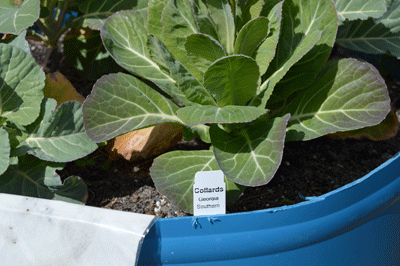 The Pine Grove HYPE Team wanted to ensure meals and snacks being served at all church-hosted events would be healthy choices, and only water would be served in the fellowship hall. The group also wanted a 5-minute physical activity break incorporated into Bible Study, Sunday School, church meetings, and the afterschool program. The youth successfully advocated for all these healthy policy changes.
The Pine Grove HYPE Team wanted to ensure meals and snacks being served at all church-hosted events would be healthy choices, and only water would be served in the fellowship hall. The group also wanted a 5-minute physical activity break incorporated into Bible Study, Sunday School, church meetings, and the afterschool program. The youth successfully advocated for all these healthy policy changes.
According to the HYPE team, there wasn’t a lot of pushback. “We had people ask for sweet tea, but we stood by our water policy,” said Eric Gamble, Jr. (17).
“The policy itself was easy. Some of it was simple. Like during a meeting, stop right there and do 5 minutes of cardio. That’s easy for them to do,” said Alex. “But, when it comes to just serving water at an event, now you’re interfering with someone’s committee. But it all worked out. Everything in the policy got approved, and I don’t think we had to actually change anything. So, they were pretty open to it.”
All the policies also apply to the afterschool program. Kids are encouraged to go outside and play. The church provides access to jump ropes, balls, and green spaces.
“We look forward to going outside, being ourselves, and going outside to play with each other,” said Elise Gamble (11).
Church Garden
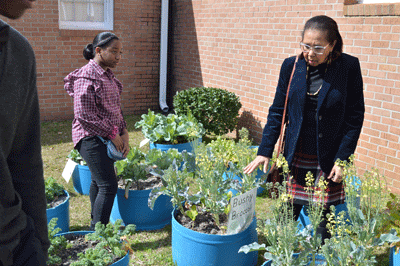 It’s a small church garden, but it’s the start of something big and it’s full of purpose. With the help of a congregation member with experience in gardening, the HYPE team created a garden out of plastic barrels cut to the size of planters, which saved a lot of time with removing grass and cultivating the soil.
It’s a small church garden, but it’s the start of something big and it’s full of purpose. With the help of a congregation member with experience in gardening, the HYPE team created a garden out of plastic barrels cut to the size of planters, which saved a lot of time with removing grass and cultivating the soil.
“We saw it was something the church could do and that we could rent to other places. It just made sense to be sustainable and grow healthy food. That way you’re not only learning new things but you’re also eating it,” said Alex.
“When we started this, the kids were green. That’s something people don’t do anymore. They don’t have gardens,” said Miranda. “What would’ve taken us 15 minutes to plant seeds, it took us two hours. Our instructor who was teaching us was very meticulous. What was most exciting was when people would come to church and see it grow.”
The garden is in a green space near the entrance to the church, so as congregants arrived, it piqued their interest. According to Miranda, they were very curious about the garden and asked, ‘What are you going to give to us,’ ‘When can we eat some,’ ‘Who is this for,’ or ‘I’m going to pick those greens.’
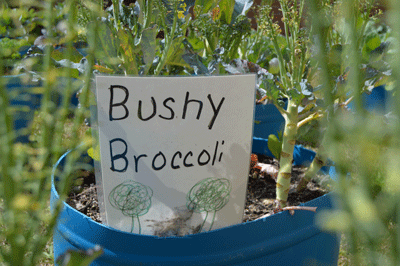 Again, Miranda let the youth do all the work and take care of the garden. The church hosts an afterschool program, so the kids were responsible for watering the garden twice a week. They even created some creative signs for the plants, like Bushy Broccoli and Cool Collards.
Again, Miranda let the youth do all the work and take care of the garden. The church hosts an afterschool program, so the kids were responsible for watering the garden twice a week. They even created some creative signs for the plants, like Bushy Broccoli and Cool Collards.
“The kids enjoy it. The kids are always ready to mess in the garden and go outside and play. The grown-ups, they enjoy it too. They like that their kids are liking to go outside, are moving more, and not staying inside playing games and being in front of a screen,” said Eric.
The Future
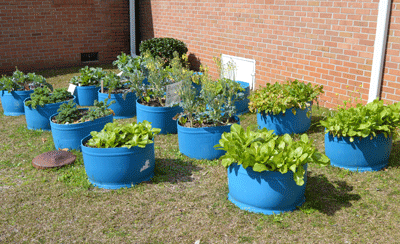 The Pine Grove HYPE Team plans to continue their garden with the next planting in Spring 2020. They’ll plant a variety of vegetables – tomatoes, cucumbers, squash, etc. They eventually want to increase the amount of food they produce and give it to the senior members of their church and ultimately, to the community.
The Pine Grove HYPE Team plans to continue their garden with the next planting in Spring 2020. They’ll plant a variety of vegetables – tomatoes, cucumbers, squash, etc. They eventually want to increase the amount of food they produce and give it to the senior members of their church and ultimately, to the community.
As far as physical activity goes, they’re planning on building a basketball court that can be used for other youth activities like dodgeball or kickball. They’re also planning on creating a walking path in the adjacent parking lot.
“I think all of the outside field activities can be for the community. If they come consistently, the parents might see there’s a church and could be interested in attending,” said Alex.
The HYPE Project has taught youth the importance of being involved in their community and helping others. It’s also taught them some personal lessons. When they first heard about The HYPE Project, they weren’t sure what they were getting themselves into. They said they never intentionally thought about eating healthy, but now they do.
When asked what they think about The HYPE Project after creating an action plan, working with leadership, and implementing the changes, they all agreed that it has been a positive experience.
“It’s great. I’m not just saying it because they gave us money. That’s also good. But everything we’ve talked about as far as helping the kids, helping the adults. It’s definitely something that more communities need. I think we all love it. The kids love it,” said Eric.
Elise said, “I wouldn’t want to change it because everyone’s working together to make it happen.”
“I think it’s a big impact. When we first thought about it, we really didn’t know what it was,” said Amari Rogers (16). “It really helped us grow. It helped me focus more on what I eat and making healthy choices.”
Alex said, “I had to talk to people to get the HYPE Project passed and working to create a policy. It might not be the same in terms of politics, but the process of creating it was still the same. That definitely helped me in other areas, and then again, just the people skills, the social skills in working with Eric on creating the video and talking to everyone else. So, everything kind of went hand in hand preparing me for other things.”

Mar 20, 2020 | Community News, Mini-Grant Success News, News
 Off I-85 in the Upstate is Pelzer, SC, a small community located in a food desert. While many associate this corridor with the City of Greenville, a vibrant metropolitan area, there are communities in the county that don’t have resources like grocery stores within a reasonable distance or the transportation to get there.
Off I-85 in the Upstate is Pelzer, SC, a small community located in a food desert. While many associate this corridor with the City of Greenville, a vibrant metropolitan area, there are communities in the county that don’t have resources like grocery stores within a reasonable distance or the transportation to get there.
Pelzer is one of those rural, tight-knit communities that’s rich in family history and a church of nearly 200 members that cares deeply for others. Shady Grove Baptist Church built a church garden to nurture its members and community members. The church garden has been there for a few years now, getting bigger each planting season with enough fresh vegetables to feed more than one hundred families.
“Oh, my goodness! We have had so much. Our goal was for the food to be given to our senior citizens and people in the community who are in need. Truly, we have done that,” said Mamie Mills Reid,
Ministry Development Coordinator. “Just this year (2019) alone, we have given over 150 packages of vegetables. We had people come to the church and get what they wanted. We gave away food at two other locations. It’s just been so productive.”
It has taken a few years for the church to get the garden where it is now. With the help of technical assistance from LiveWell Greenville and grants from Gardens for Good and Eat Smart Move More South Carolina, the church family created a large garden, helped reduce food insecurity for many families, and encouraged members to adopt a healthy lifestyle, which has helped some overcome health issues.
Laying the Foundation
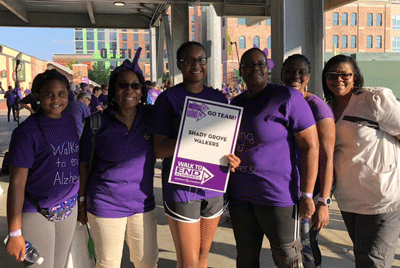 Years ago, Shady Grove joined LiveWell at Worship, a focus area of LiveWell Greenville that supports congregations in creating healthier worship environments through healthy eating and active living initiatives. It was through this initiative that Shady Grove leaders started their mission to provide congregants with opportunities to make healthy choices at church.
Years ago, Shady Grove joined LiveWell at Worship, a focus area of LiveWell Greenville that supports congregations in creating healthier worship environments through healthy eating and active living initiatives. It was through this initiative that Shady Grove leaders started their mission to provide congregants with opportunities to make healthy choices at church.
They adopted policies, such as water only, no fried foods at church-hosted meals, and no saltshakers on tables. Every third Sunday, they host health screenings. Leaders have also incorporated walking into the mix by participating in the Alzheimer’s Walk.
“Our pastor invites congregants to walk with him. You would be surprised at the number of people who walk with him. We had about 35 people at the last walk,” said Mamie. “It’s for three purposes: it’s for Alzheimer’s; it’s for comradery; and it’s for the exercise.”
The Garden
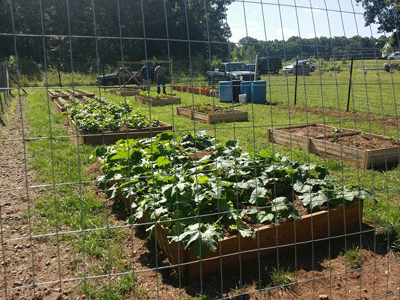 During a LiveWell Greenville meeting, Mamie and her pastor heard about a grant opportunity from Gardens for Good. They knew the church was in a food desert and they wanted to do something to help the community, so they applied in 2015 and received the grant to build raised bed gardens.
During a LiveWell Greenville meeting, Mamie and her pastor heard about a grant opportunity from Gardens for Good. They knew the church was in a food desert and they wanted to do something to help the community, so they applied in 2015 and received the grant to build raised bed gardens.
“Our people here don’t have transportation and they can’t go to the grocery stores and get fresh food but we thought it would be such an excellent thing to actually grow the fresh produce on the campus, and let our people partake of it,” said Mamie.
The garden helps provide nutritious food to the community and shows the younger people where vegetables come from. “They don’t come from Publix. They don’t come from Bi-Lo and Ingles. They come from the ground,” said Mamie. “So, it has been a wonderful teaching experience for them. My husband has taken our younger men and ladies down to the garden and they have participated in the growing.”
 Skip ahead to 2018 when Shady Grove heard about an ESMMSC grant opportunity at a LiveWell Greenville meeting. They decided to press their luck and apply for a Let’sGo 3.0 mini-grant.
Skip ahead to 2018 when Shady Grove heard about an ESMMSC grant opportunity at a LiveWell Greenville meeting. They decided to press their luck and apply for a Let’sGo 3.0 mini-grant.
“We had already started working on the garden, but this grant allowed us to purchase tools and other things that we needed,” said Mamie.
The tools made working in the garden easier. Anyone who has kept a garden, knows that a lot of time and effort goes into cultivating the soil, watering the plants, pulling weeds, and harvesting the crops. Add the hot Carolina sun in there, and that makes for a long day.
“I hope at some point we can use it as a tool with our younger generations to get more interest in gardening and healthy eating. And just getting them more interested in working,” said Janie Reid, church member and garden volunteer. “When it comes to a community garden, the Biblical saying is true: The harvest is plentiful, but the laborers are few. It’s hard to make yourself get out there in 90-degree weather and pull the Bermuda grass and water the garden.”
Changing Lives
 Eating a healthy, balanced diet and getting exercise are key elements to living a healthy life. And that’s what the LiveWell at Worship initiative and the garden have done for many church members – it’s changing lives.
Eating a healthy, balanced diet and getting exercise are key elements to living a healthy life. And that’s what the LiveWell at Worship initiative and the garden have done for many church members – it’s changing lives.
Gail Canty is a church member and benefactor not only of the garden, but also of the entire health and wellness program. She grew up eating fried foods and drinking sugar-sweetened beverages, even though she ate from the garden her father tended. As an adult, she developed Type 2 diabetes.
“It’s good that we have baked foods, more salads, and don’t go heavy on the carbs at church. It’s helped me a lot to keep my diabetes in control. With lifestyle changes, for me, I don’t have to take any medication at this point. I’m been off diabetes medication for almost a year. For me, I attribute it to eating better and walking.
“Since we are a wellness church, we do the chair exercises and other things to keep moving, and I think that helped me. It motivates me to continue those healthy rituals when I’m at home.
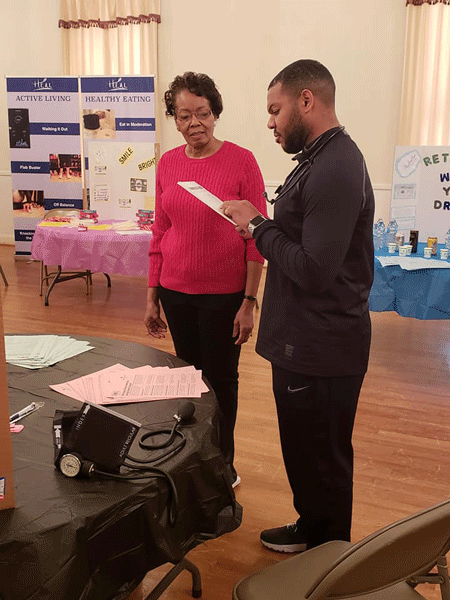 “We have nurses here at church who encourage us to drink water. That motivated me to switch from juices to water. I’m not a soda drinker, but I was a juice drinker. Even at church events, they have bottled water and that helps me. If I’m going to do it here, I may as well do it at home.”
“We have nurses here at church who encourage us to drink water. That motivated me to switch from juices to water. I’m not a soda drinker, but I was a juice drinker. Even at church events, they have bottled water and that helps me. If I’m going to do it here, I may as well do it at home.”
Shady Grove Baptist Church isn’t just looking out for their own. They seek out people who aren’t members of the church to feed. “Just about everyone in this community belongs to Shady Grove, but I know that there was a disabled members’ neighbor who was not a member of this church, and she would always benefit from the garden. We have another lady who is widowed, and we make sure she gets vegetables. So, we do identify anyone who is 65 or older and we make sure they benefit from the garden,” said Janie.
The entire wellness program at Shady Grove Baptist Church seems to be a great success. From guest speakers, walks, and health screenings to the garden, fellowship, and youth engagement, the people of Shady Grove are truly making healthy change happen for their community.
“It’s such an opportunity for the church and the community to grow in a different area other than just spiritual because the spiritual makes the physical. These bodies are supposed to be tended to very well,” said Janie.

Mar 20, 2020 | Community News, Mini-Grant Success News, News
 Eat Smart Move More South Carolina (ESMMSC) is pleased to announce $30, 944.81 has been awarded to eight communities in the Lowcountry, Midlands, Pee Dee and Upstate regions of the state. For the past two-and-a-half years, ESMMSC has been funding communities around the state to increase access to healthy food and safe places for physical activity.
Eat Smart Move More South Carolina (ESMMSC) is pleased to announce $30, 944.81 has been awarded to eight communities in the Lowcountry, Midlands, Pee Dee and Upstate regions of the state. For the past two-and-a-half years, ESMMSC has been funding communities around the state to increase access to healthy food and safe places for physical activity.
“This application round was the largest response we’ve received yet, which makes choosing the recipients more difficult,” said Kelsey Allen, Manager of Community Initiatives at ESMMSC. “We received 53 applications that were all deserving of funding, but we only had enough funds to award eight communities this time.”
Reviewers, located around the state, judge applications using set criteria, such as policy, system, and environmental change; health equity, underserved populations, and community accessibility, and community impact. For applications that were not accepts, technical assistance is provided, and, oftentimes, applicants are connected to ESMMSC partners who can help move the project along.
In June 2020, the application for the final round of mini-grants will open. Funding is made possible by The BlueCross® BlueShield® of South Carolina Foundation, an independent licensee of the Blue Cross and Blue Shield Association.
Round 4 Grant Recipients
Carolina Youth Development Center (CYDC) will plant a campus garden to serve its residents and the community. The goal is to implement a self-sustaining project that will allow kids to plant and grow food, process it in CYDC’s DHEC-certified commercial kitchen facility, and ultimately, sell it through a partnership with Lowcountry Street Grocery, an organization that delivers a mobile market to food deserts in the greater Charleston community. CYD will also partner with the Green Heart Project, which will design a garden space on CYDC’s to initially include seven raised garden beds. They will also use Green Heart Project’s science-based curriculum to engage residents in an after-school activity that teaches farm-to-table production.
Fort Lawn Community Center is partnering with the Town of Fort Lawn, Community Heart and Soul Team, and Eat Smart Move More Chester County to make improvements to a local playground, making it more user-friendly for youth and families. This idea is one of the findings during a walkability study. In addition, the Community Heart and Soul team interviewed hundreds of residents and visitors to the Fort Lawn and concluded that a major concern is a lack of recreational facilities. This project will encourage greater use of the playground by individuals and families through better signage, revamped edging and mulch for equipment, and improvements to parking. Plans include adding signage on major roads and in neighborhoods, purchasing and installing edging, mulch, and rock during a volunteer project day, publicizing the improvements, and determining a method for tracking usage of the playground.
Ladies Divine to Shine will convene a Healthy Young People Empowerment (HYPE) team to engage youth leaders in creating a food policy council representing Lamar, SC and its surrounding communities. The HYPE Team will conduct activities to promote more consumption of fruits and vegetables, decreasing consumption of sugar-sweetened drinks, decreasing unhealthy snacks and reducing portion size and increasing physical activity. They will also conduct a healthy eating and physical activity assessment of the area, as well as lead physical activities for students during the summer months.
The Town of Paxville will renovate Paxville Community Park to make it accessible and inclusive for all residents. The intention of this project is to facilitate increased and diverse usage of the park as well as to encourage healthy living habits and fellowship among community members. While some of the park features are usable, the park as a whole does not currently present itself as a modern or inspiring space for the public to utilize or gather. This park project reflects the growing needs and interests of the community to cater to a young and rural population by offering modern, mixed-use, and health-oriented services. In parallel, the town is also conducting the process to obtain its own ambulance.
The Saluda High School HYPE Team will focus on improving Brooks and Rand Memorial Park, or “The Field.” Over the years, the park has been neglected. It no long has electricity and service. The park equipment is old, unusable, and unsafe. Tall grass, litter, and graffiti now pollute the area. The students believe that restoring and revitalizing the park will provide a safer and more accessible outlet for community members to get out and become physically active. The HYPE team will partner with community leaders and volunteers to install signage, replace benches and basketball goals. Other park improvements will be implemented that can lead to longer-standing changes in the Brooks and Roston Memorial Park and surrounding community.
The South Carolina School for the Deaf and Blind Foundation (SCSDBF) wants to build upon its Pathways to Healthy Living Initiative by installing water refill stations on its campus, which will not only impact the students and faculty, but also the surround community that uses the Fluor Field House for physical activity. This project will resolve a safety issue for students who have difficulty using current water fountains from 1969. In addition to installing new and modern water refill stations, SCSDBF will use the funds to retrofit some water fountains with a water bottle refill fitting. By installing both new and retrofitted bottle filling stations, SCSDBF will make it easier for students, staff, and community members to adopt the healthy habit of drinking fresh water
St. James-Santee Elementary/Middle School will intentionally reach a pocket of Charleston County that has limited resources by installing inclusive playground equipment and bicycle stands, providing bicycle locks, and building a bike trail to connect the school campus to nearby trailheads. School leaders will also strengthen their open community use policy to allow parents/caregivers and their children to use the playground and biking trail during the weekends, school breaks, and summer. The project, in partnership with the Town of McClellanville and Francis Marion National Forest, will address community needs by providing free opportunities and easily-accessible space for the community to be active.
Keystone Substance Abuse Services will improve an existing walking path located on its campus. The walking path us rundown and not fully paved, oftentimes ending up as a mud pit after rainfall. The walking trail loops from the front of the building to the back of the building and creates an approximate .25 mile loop, and it’s the only recreation space that patients can access. Funding will support the pavement of the trail to allow our patients more access to a walking trail to increase physical activity. Evidence shows that physical activity can help provide structure, generate positivity, distract from cravings, and heal the body and brain. Long term plans include creating fitness stations for patients and staff to increase overall wellness for individuals.

Mar 20, 2020 | News
 BY BEN COHEN
BY BEN COHEN
USC STUDENT VOLUNTEER
You may not realize it, but the US Census actually has a direct impact on how federal programs receive funding. What is the Census used for? How does it have an effect on healthy eating and active living? Why should all this matter? How can you do your part and complete the Census? With national census day quickly approaching on April 1st we here at Eat Smart Move More South Carolina (ESMMSC) would like to discuss how your participation in the 2020 Census will help to promote healthy eating and active living in your community.
What is the Census used for? The 2020 US Census will be used to determine how much funding over a hundred federal programs will receive. In 2015, there were 132 federally funded programs that used Census data to receive around $675 billion annually. These programs encompass all kinds of health and wellness initiatives, as well as public services and environmental projects.
How does the Census promote healthy eating and active living? Federal agencies such as Supplemental Nutritional Assistance Program (SNAP) and the National School Lunch Program have funding determined by the Census. SNAP provides families who are financially struggling with monetary assistance to purchase healthy foods that they would not otherwise be able to afford. The National School Lunch Program provides free or reduced cost nutritious meals to school aged children. In addition to healthy eating, Census data also impacts active living by informing funding for parks, playgrounds and community centers. These are just a few of the many ways programs dedicated to healthy eating and active living receive their funding based on the results of the Census.
Why should this matter to you? Once the Census is released, you will be able to directly see the impacts of it. Federal programs of all kinds will receive new funding amounts and will adapt accordingly. If these programs are able to help encourage healthy lifestyles then our nation as a whole will be healthier.
How can you do your part? Now that you know how the Census can benefit you and your community, let’s talk about how you can fill it out. The Census is filled out online at www.My2020census.gov. At this point you should have received a letter in the mail that gives you a 12-digit ID number. Once you have that, it will only take around 10 or so minutes to complete. It is easy to do and provides a great benefit!

 Since March 13, Eat Smart Move More South Carolina (ESMMSC) has worked with more than 100 statewide partners to provide emergency preparedness materials and healthy food source locations to partners and the public in the wake of the COVID-19 pandemic.
Since March 13, Eat Smart Move More South Carolina (ESMMSC) has worked with more than 100 statewide partners to provide emergency preparedness materials and healthy food source locations to partners and the public in the wake of the COVID-19 pandemic.


 The Pine Grove HYPE Team wanted to ensure meals and snacks being served at all church-hosted events would be healthy choices, and only water would be served in the fellowship hall. The group also wanted a 5-minute physical activity break incorporated into Bible Study, Sunday School, church meetings, and the afterschool program. The youth successfully advocated for all these healthy policy changes.
The Pine Grove HYPE Team wanted to ensure meals and snacks being served at all church-hosted events would be healthy choices, and only water would be served in the fellowship hall. The group also wanted a 5-minute physical activity break incorporated into Bible Study, Sunday School, church meetings, and the afterschool program. The youth successfully advocated for all these healthy policy changes. It’s a small church garden, but it’s the start of something big and it’s full of purpose. With the help of a congregation member with experience in gardening, the HYPE team created a garden out of plastic barrels cut to the size of planters, which saved a lot of time with removing grass and cultivating the soil.
It’s a small church garden, but it’s the start of something big and it’s full of purpose. With the help of a congregation member with experience in gardening, the HYPE team created a garden out of plastic barrels cut to the size of planters, which saved a lot of time with removing grass and cultivating the soil. Again, Miranda let the youth do all the work and take care of the garden. The church hosts an afterschool program, so the kids were responsible for watering the garden twice a week. They even created some creative signs for the plants, like Bushy Broccoli and Cool Collards.
Again, Miranda let the youth do all the work and take care of the garden. The church hosts an afterschool program, so the kids were responsible for watering the garden twice a week. They even created some creative signs for the plants, like Bushy Broccoli and Cool Collards. The Pine Grove HYPE Team plans to continue their garden with the next planting in Spring 2020. They’ll plant a variety of vegetables – tomatoes, cucumbers, squash, etc. They eventually want to increase the amount of food they produce and give it to the senior members of their church and ultimately, to the community.
The Pine Grove HYPE Team plans to continue their garden with the next planting in Spring 2020. They’ll plant a variety of vegetables – tomatoes, cucumbers, squash, etc. They eventually want to increase the amount of food they produce and give it to the senior members of their church and ultimately, to the community.
 Years ago, Shady Grove joined LiveWell at Worship, a focus area of LiveWell Greenville that supports congregations in creating healthier worship environments through healthy eating and active living initiatives. It was through this initiative that Shady Grove leaders started their mission to provide congregants with opportunities to make healthy choices at church.
Years ago, Shady Grove joined LiveWell at Worship, a focus area of LiveWell Greenville that supports congregations in creating healthier worship environments through healthy eating and active living initiatives. It was through this initiative that Shady Grove leaders started their mission to provide congregants with opportunities to make healthy choices at church. During a LiveWell Greenville meeting, Mamie and her pastor heard about a grant opportunity from Gardens for Good. They knew the church was in a food desert and they wanted to do something to help the community, so they applied in 2015 and received the grant to build raised bed gardens.
During a LiveWell Greenville meeting, Mamie and her pastor heard about a grant opportunity from Gardens for Good. They knew the church was in a food desert and they wanted to do something to help the community, so they applied in 2015 and received the grant to build raised bed gardens. Skip ahead to 2018 when Shady Grove heard about an ESMMSC grant opportunity at a LiveWell Greenville meeting. They decided to press their luck and apply for a Let’sGo 3.0 mini-grant.
Skip ahead to 2018 when Shady Grove heard about an ESMMSC grant opportunity at a LiveWell Greenville meeting. They decided to press their luck and apply for a Let’sGo 3.0 mini-grant. Eating a healthy, balanced diet and getting exercise are key elements to living a healthy life. And that’s what the LiveWell at Worship initiative and the garden have done for many church members – it’s changing lives.
Eating a healthy, balanced diet and getting exercise are key elements to living a healthy life. And that’s what the LiveWell at Worship initiative and the garden have done for many church members – it’s changing lives. “We have nurses here at church who encourage us to drink water. That motivated me to switch from juices to water. I’m not a soda drinker, but I was a juice drinker. Even at church events, they have bottled water and that helps me. If I’m going to do it here, I may as well do it at home.”
“We have nurses here at church who encourage us to drink water. That motivated me to switch from juices to water. I’m not a soda drinker, but I was a juice drinker. Even at church events, they have bottled water and that helps me. If I’m going to do it here, I may as well do it at home.”



